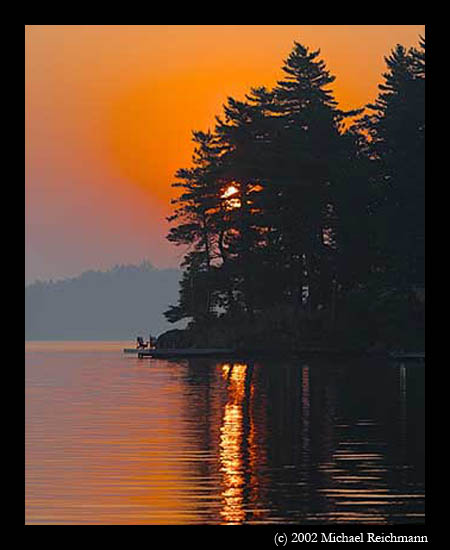
Join our community and recieve updates and information on upcoming interviews. If you have not yet registered, you can register here. Registering is easy and painless. We hope that you join us in the forums for discussions.
This interview took place on March 14th 2005 via phone between James Morrissey and Michael Reichmann. Some of this text has been paraphrased.
This article is Copyright 2005, James Morrissey, and may not, in part or in whole, be reproduced in any electronic or printed medium without prior permission from the author. The images in this article are the property of Michael Reichmann and have been licensed to James Morrissey and the NWP Photo Forum for the purpose of this article.
NWP note: The purpose of this interview is to educate people in our community about nature photography by presenting an accomplished nature photographer. We are thrilled to bring to you our very first interview. We are thankful that Michael Reichmann has agreed to share with us his personal life and experience of his journey to becoming one of the top nature photographers today. He is the owner of the Luminous Landscape website. He is also an avid supporter of the preservation and protection of our environment. We at NWP hope that you will find this interview informative and inspiring.

Muskoka at Dawn.
Photographed with a Canon EOS D60 and 70-200 f/2.8L IS lens @ ISO 400 & 200mm.
JM: Would you be willing to give us a short social history of yourself?
MR: I was born in England during World War II. My parents had escaped from Nazi Germany. We moved to New York when I was aged four. Unfortunately, my parents were unable to get permanent residency in the United States and so my family immigrated to Canada. I spent the formative years of my life in Montreal.
I moved to Toronto in the mid 1960s after I finished University and have lived here ever since. I have two siblings who got married and moved to the United States. I got married in my early 30s and had one child. I am currently living in Toronto.
JM: When and how did you first begin to photograph?
MR: My parents gave me my first camera at the age of 10. It was a Kodak Box Brownie. I developed a great interest in photography, and photographed everything. My parents, having seen my interest, then purchased a developing kit for me.
My passion for photography continued to grow. I was not just interested in taking pictures, but I was an avid reader as well. I focused heavily on the work of Andreas Feininger, Walker Evans and Elliot Porter.
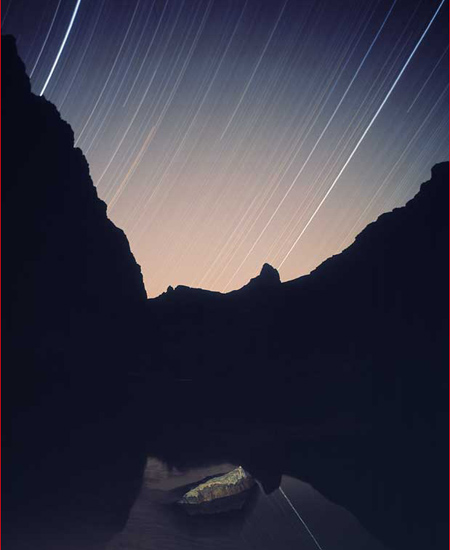
Star Trails (c) 2002 Michael Reichmann
Photographed with a Hasselblad ArcBody and 45mm Rodenstock lens on
Provia 100F
JM: You have indicated that you had your first exhibit at the age of 20. How did that come to pass?
MR: My early interests and training were in photo-journalism. As I was living in Montreal during the early 60s I took a great interest in the various protest demonstrations and movements. Much of my early work reflects these demonstrations. At the age of 18, I had a small gallery exhibit that some people from the CBC (Canadian Broadcasting Corporation) saw. They liked the work and developed a 30 minute TV documentary out of my still images.
JM: This was the beginning of your professional photographic career?
MR: It was this experience that later helped me get a job as a staff photographer for the CBC. I worked as a staff photographer at the CBC for 9 years. However, the life of a vagabond can wear thin and I eventually got married and settled down while I was in my early 30s. I decided to find more stable forms of income, and at this time,photography ceased to be a significant source of income; however, it was still the thing that I did. As I have said before, it is my passion.
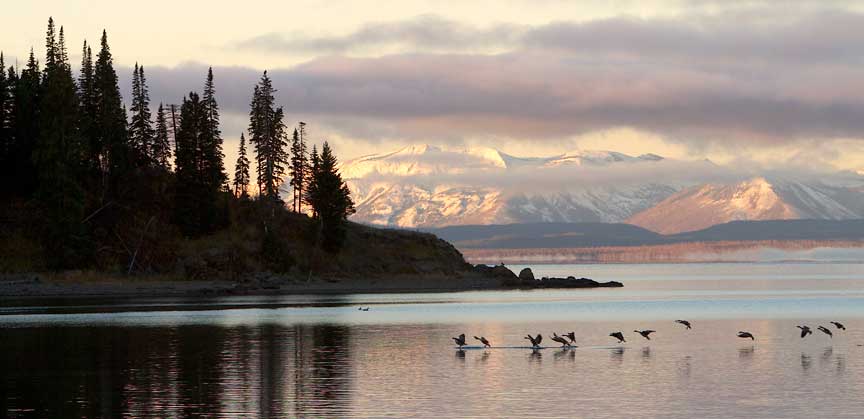
Lake Landing — Yellowstone Lake, October 2002
Canon EOS D60 with 70-200mm f/2.8L IS lens at ISO 100. EFL=232mm
During this time in my life, I had a wide variety of different jobs, so I am going to give you the short version. I must have changed my career at least 8 times. After leaving the CBC, I worked for about four years as a free-lance photographer doing stills for the film industry. I eventually left this job and took up a position at Rutherford Photo, Canada’s largest pro retailer at the time, where I eventually became the store manager. I became Canadian product manager for Sinar view cameras and then eventually National Sales Manager for Panasonic's Video Division.Ultimately, however, I left there and wound up going into my own businesses. This was the late 70s and personal computers were beginning to come into their own, however, the IBM PC was not dominant yet. I developed a piece of software for Commodore and Atari computers called B-Graph, a business graphics software package. The software did very well and it was ported over to some of the other computer platforms. I then join a young software publishing firm called 'Batteries Included', and eventually became its President. I sold it in the late 70s to Electronic Arts.
My last large venture before returning to photography was a telecommunications company called "AlphaNet Telecom." My work at AlphaNet yielded several patents that I still hold today. While with AlphaNet, we were responsible for several innovations including early versions of Voice Over IP and a service for the hotel industry called 'InnFax.' When I helped develop InnFax, the Internet still really did not exist and everyone was sending things via fax. This product allowed hotels to put a fax on the same line as a phone in a hotel room. In effect, people in a hotel rooms could send and receive faxes and telephone calls on a single line.
In 1994 I was introduced to the Internet and I became intrigued. We found a 19 year old techy, who incidentally later went on to become an Internet millionaire, and hired him for a couple of days to show us what Internet was about technically. Over time concepts from this beginning developed into some of the earliest Voice Over IP technology, which was subsequently sold to various telecom companies. I left the telecom industry in 1997.
JM: Curiously, what is your education in?
MR: I have a Bachelor's Degree in Philosophy and Political Science.
JM: Considering you different work in all these tech firms, I am surprised with your background that you do not have a degree in Engineering.
MR: The fact that I don't always know something does not scare me. I just go and learn it. Part of being a successful businessperson does not always mean knowing exactly how to create a product. It does mean knowing what the market needs and where to go with it. To use perhaps not such a great analogy, I am sure that some of the best Formula One drivers often do not know how to design their race cars. They just know how to drive it really well.
JM: This is where you decided to re-enter the photographic business. Where does The Luminous Landscape fit into your business?
MR: It is important to note that during the time that I was no longer earning my income solely through photography that I was still photographing constantly. I never gave up my photographic life just because I was making a living elsewhere. Photography was what I did. In addition to the photography, I also did a lot of teaching at local colleges.
My business with the Luminous Landscape falls into two main pieces, the web site and our Video Journal DVD series.They came about when I finally became semi-retired in 1997. At the time I was developing the website, filmmaker Chris Sanderson and I spoke to some cable TV networks about putting together a show on photography. This lead to several networks asking us if we could put together a show for them - the problem is that they wanted 26 one hour segments. We did not want to do this full time and began to examine alternative products that we could produce at our own pace. We decided that the way to go is to self-publish. This is where the idea of the Video Journal was born. The great thing about self-publishing a product is that it is designed around our time-lines without being beholden to anyone - so long as the people who buy the DVDs are happy.
I started the Luminous Landscape website in 1997. Over the years I had written quite a number of articles for Photo Techniques magazine, where I am a Contributing Editor. Once these articles are off the newsstand I am free to reuse them, and this lead to the creation of The Luminous landscape web site.
The website now has about 35,000 unique visitors a day; about 500,000 visitors per month. The website generates no income and was designed to be free. It is one of the ways that I give back to the photographic community.
Because the website is free, it exposes us to a lot of people who otherwise might not come to the site. The website has also been a vehicle for people to become aware of the Video Journal series. I also feel that the fact that the website is free helps us with the public in that they know that when I publish my opinion that it is without any financial bias toward the product being reviewed. My opinions - be they good, bad or ugly - are my own, and people respect that. I have been offered many opportunities to accept advertising, but we have not accepted them.
The Video Journal is a quarterly publication that is filled with tutorials, location shoots, interviews and product reviews. Like the website, it is free from commercial bias. The Video Journals are mostly focused on things that I am personally interested in and places that I want to go.
JM: Do you think you would be able to be in the same business today if you did not have your background experiences?
MR: That is a hard one. I think that I want to answer it in a slightly different way. To be successful in ANY activity, you must find a way to stand out from the crowd. You must be able to identify a market, bring out a product and have it be seen as special. In marketing, a 'USP' or Unique Selling Proposition is everything. Having a good idea and being creative is just not good enough. For example, there are lots of technically competent photographers out there - unfortunately, most photographers fail in business because they are not able to distinguish themselves beyond the pictures.
What it is you have - and who you are selling it to - is key. I often hear from people who want to get into wildlife and nature photography. They think that they want to shoot for National Geographic. The short answer is 'Well forget it. That probably won't happen.' So, what is next? Selling stock photography? People don't understand how hard it is to develop a really good stock photography catalog. It requires being out in the field 250 days a year or more. That is a really hard lifestyle and is particularly difficult if you have a family or any serious commitments. The reality also is that you cannot approach the stock photography industry without thousands of photographs already in hand.
People often ask me the best way then to break into the stock photography business. Unfortunately, there is not one best way. I would suggest however, that people consider the idea of apprenticeship. Be willing to carry someone's bags for them or file their negatives - or whatever is required in order to learn and make the contacts.
However, ultimately, the people who seem to end up succeeding in whatever aspect of the business that intrigues them are the ones who don't even need to ask the question. Photography is just like any other field. It requires as much talent as it does chutzpah. When I hear people say that “they want to quit their day job and photograph full time," well the truth is about 1 in a million actually will succeed at it. There are ways to do both though.
First, keep your day job. Buy decent, but not super-expensive equipment, and take some pictures. You don't need the most expensive equipment in order to take great photographs. Have IT be your passion. Then go out and show your work. Try to get some small shows and do some teaching. Don't try to do the impossible. Do what you CAN do. If you can do the impossible, you do not need my advice. [laughs] If you can keep your day job and find a way to keep photography your passion, you are probably best off. Do this because it is WHAT you do.
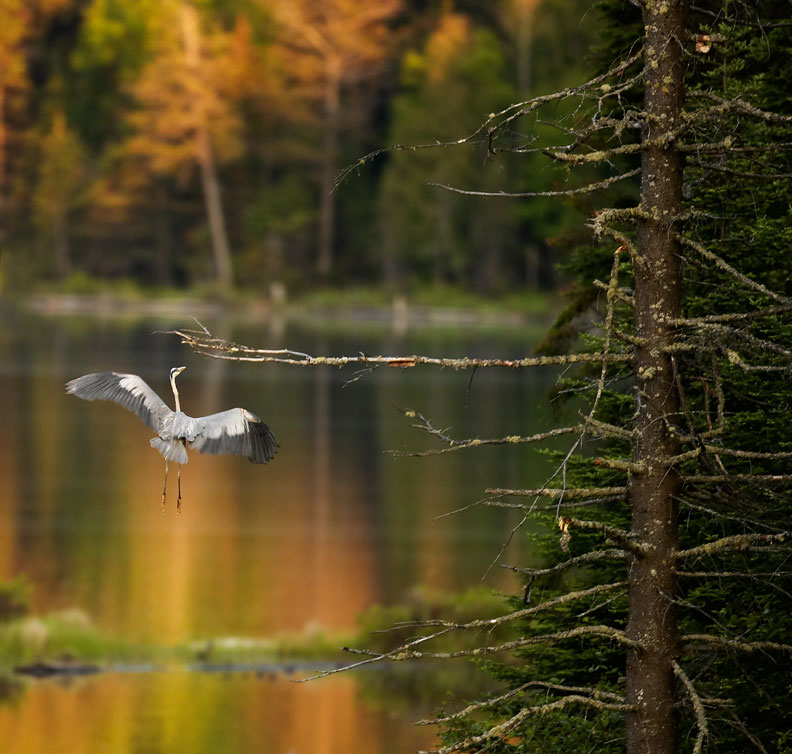
Vertical Landing — Algonquin Provincial Park, Ontario. June, 2003
(Crane)
Photographed
with a Canon 1Ds and 500mm f/4L IS lens. ISO 200
You see, since the web site was started as a labor of love, it was started with no expectations and no business plan. It was not seen as a traditional business. While my workshops are certainly successful and profitable - and I would not do them if they were not - the money is a secondary motivation. The website has turned into a great part of my business, but it has been a labor of love.
JM: Michael, can you tell me what a typical day is like for you in the field? Also, what kind of equipment do you bring? What percentage of shots do you feel are sellable?MR: My days in the field start typically a couple of hours before sunrise and end after sunset.
I will almost always scout a location the day before, and then depending on how long a drive it is from where I'm staying to that location, I'll get up with enough time to drive and be there about an hour before sunrise.
By 2 hours after sunrise the best light is over, and I spend the rest of the day driving between locations, and scouting locations for that evenings and the next morning's shoots.
Since I fly to most locations and then rent a car, the amount of gear I bring is usually limited by what I can carry on the plane. I won't check my cameras and lenses, though I do check my tripods, chargers and other less fragile and expensive equipment.
I always have two bodies, and also a selection of lenses, to match what I expect to be shooting. For example, if I'm shooting wildlife I'll bring long lenses, and if focusing on landscape work I'll bring tilt/shift lenses. I also bring a laptop computer and enough storage to handle everything that I might shoot as well as to make in-the-field backups of all files.
My "success" rate is about 1% of what I shoot.
JM: Thanks for talking so frankly about the economic aspects of wildlife and stock photography. Now to something completely different...one of the aspects of NWP that I hope will develop is the forum about environmental activism. Do you see yourself as an activist?
MR: It is hard to be an outdoor photographer and NOT see yourself as an activist. However, you need to have your causes and stick to them. To give you an example, I was in Bangladesh recently. You may remember some of the articles from the website -- www.luminous-landscape.com. Many of these places often do not allow photographers to walk around the industrial areas because many of these places are an environmental disaster...with ships leaking oil and other contaminants into the water and ground. On one occasion a photographer took some pictures that were picked up by Green Peace and they created a great many problems for the industry there.
I was able to get into one of the ship-breaking yards because I had some connections and also because I see myself as a social documentary artist and not just as an environmentalist (which I am). The photographs were made to tell a story. However, if these photographs somehow get used in a way that it helps to create a greater awareness about the environment, then so be it.
JM: Which environmental groups do you feel do the best work?
MR: There are lots of great activist organizations out there, however, we all pick the ones that we like the best and beat those drums. I think that you have a much greater impact by picking two or three places to donate your money to than by giving 5 dollars here and 10 dollars there to different places. The Nature Conservancy is the one that I support.
The Nature Conservancy is a great group. The purchase land around National Parks using private money to protect them from development -- http://nature.org. It turns out that they already have a lot of good photographers and they don't need my images. What they need is my (and your) money. You cannot just support the environment by taking a few pretty pictures. You need to support them with your wallet.
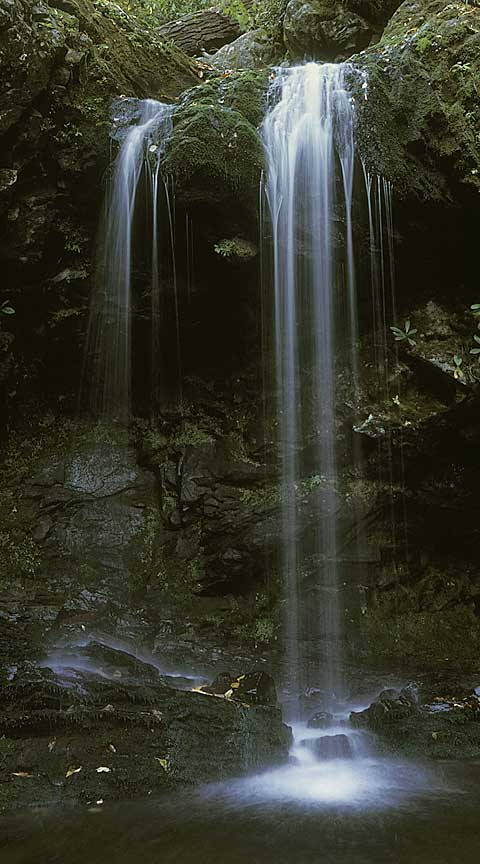
Grotto Falls, Great Smoky National Park. October, 2000
Photographed with a Hasselblad XPan and 30mm and 45mm lenses on Provia 100F
You see, it is hard to be a photographer without being an environmentalist. I want for my kids kids to be able to see a moose years from now or to be able to climb a mountain without stumbling over trash. This can only be done by people who protect the environment with their donations.
JM: Thank you very much for your time, Michael. I appreciate your spending me with me as you have tonight.
MR: You are welcome, it was my pleasure.
Thanks again to Michael Reichmann for having sat with me for this interview. Feel free to come join us in the NWP Business Forum to discuss any interesting aspects of this interview. Also, you may want to check out the Nature Conservancy website. They sound like they do great work -- http://nature.org.